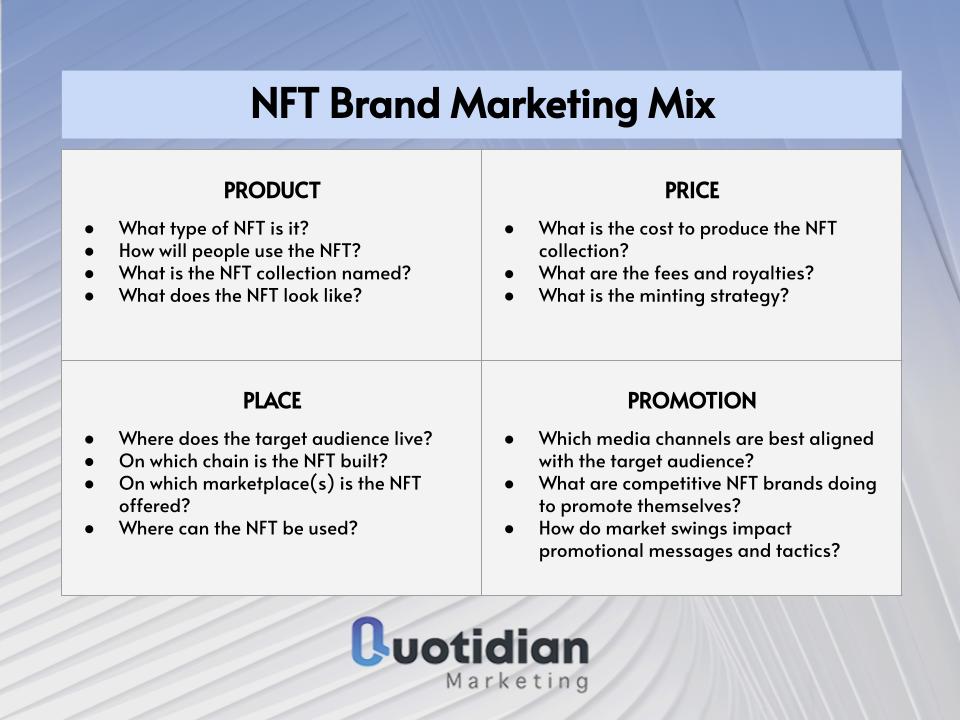The Marketing Mix concept, also called the "4 Ps" (Product, Price, Place, Promotion) originated in 1960 and has withstood the test of time - and technological disruption. Although nascent industries may appear to break traditional marketing rules, there is no escaping the strategic calculus of 4 Ps analysis. Cryptocurrency and NFT brands may struggle to place themselves in the 4 Ps matrix, but the process of doing so will reveal marketing tactics needed to best the competition.
Quotidian Marketing did some of the work for you with this NFT Brand Marketing Mix matrix (download PDF). Use this tool to evaluate your brand's strengths and weaknesses relative to your competitors. Once a weakness is identified, the 4Ps methodology assists in making calculated adjustments to promotional strategies, product development, and more.

Product
The Product component of the Marketing Mix focuses on what the brand sells- this may be a product and/or service. Product considerations include questions such as:
- What is it?
- What problem(s) does it solve?
- What features does it have?
- How and where will the use customer it?
- What is it called?
In the context of NFTs, some of these questions are still open to discussion. What problem do NFTs solve? A search of recent news articles on the topic would have you believe that digital artwork ownership rights are the problem NFTs are meant to solve. But, consumer behavior is telling a different story, with all time secondary sales of Art NFTs ($476,000) far below that of Collectibles NFTs ($5,000,000). So, how do NFT brands define product? What are people buying when they purchase NFTs? One view is that a NFT is the combination of artwork JPEG, meta data, and liquidity (in the forms of marketplace viability and community size). Ultimately, consumer usage of NFTs will dictate the desired product features - many of which may not exist today.
Price
The Price component of the Marketing Mix focuses on cost to the consumer. Price considerations include:
- What is the cost of doing business?
- What is the target audience willing to spend?
- Is the target audience price sensitive?
- How does the brand's price compare to competitors?
For NFTs, the price component is nuanced and critical to the brand's success. NFT brands must consider the cost of creating, listing, and marketing an NFT when setting mint prices and determining royalty fees.
Place
The Place component of the Marketing Mix focuses on where consumers go to get the product/service in question. Place considerations include questions such as:
- Where do buyers look for your product or service?
- How can you access the right distribution channels?
- What methods are necessary to reach buyers (e.g., sales force, trade shows, online submissions)?
- Where do buyers use your product or service?
The rise of digital marketing cemented "online" as an essential location for buyers and sellers to interact. Now, the rise of cryptocurrencies and NFTs have highlighted the need to understand blockchains and marketplaces as the location components to consider. For example, NFT brands have two pivotal place decisions to make: which blockchain to build upon and which NFT Marketplaces to list on? The answers to these "place" questions will have a major impact on promotional decisions.
Promotion
The Promotion component of the Marketing Mix focuses on communicating the brand's value proposition to the target audience. Promotional tactics include press relations, advertising, influencer marketing, and content marketing. Common promotional considerations include questions such as:
- Where and when can you get your marketing messages across to your target audience?
- Which communication method(s) best reach your target audience?
- When is the best time to promote? How does market seasonality impact buyer behavior?
- How do your competitors promote and how does that influence your promotional campaigns?
For NFT brands, promotion is the difference between being seen and being invisible. There is no physical storefront that commuters will pass on their way to work. There is no Amazon marketplace to immediately tap into for buying and selling. NFT marketers must get their message in front of their target audience in order to gain momentum. When media channels are selected in alignment with target audience characteristics such as time zones and social channels, NFT brands have a better chance of standing out in a meaningful way.
Using the 4Ps Matrix
The 4Ps matrix helps brands evaluate the cohesion of their marketing strategy. As described in Harvard Business Review, "most companies would benefit from the discipline of a similar description of their marketing strategy's core. It helps ensure that the plan is clear and that the details do not obscure the strategy."
Use the 4Ps matrix to clarify your marketing strategy, evaluate the competition's strategic strengths and weaknesses, and ensure effective use of advertising spend.
Is your brand's promotional strategy aligned with its overall NFT marketing strategy? Contact Quotidian Marketing to review.